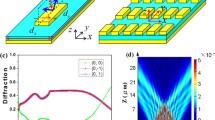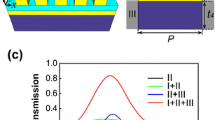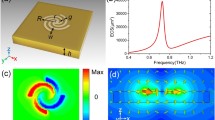Abstract
In this review, we present our recent work on making structured metals transparent for broadband electromagnetic waves by surface plasmons (SPs) or spoof surface plasmons (SSPs). First, we demonstrate that the interference between the localized and propagating SPs plays an important role in the optical transmission through arrays of sub-wavelength holes. The observed phenomena belong to the category of plasmonic Fano effects. Second, we show that the transmission enhancement originates not only from the coupling between the incident light and the excited SPs but also from the coupling among these SPs in multiple nano-aperture stacks. Finally, we demonstrate that metallic plates with narrow slit arrays can become transparent within extremely broad spectral bandwidths, and high transmission efficiency is insensitive to the thickness of the metal. This phenomenon explicitly demonstrates the conversion between light and SPs. These investigations provide guidelines to develop many novel materials and devices, such as transparent conducting panels, antireflective solar cells, and other broadband metamaterials.
Similar content being viewed by others
References
Barnes W L, Dereux A, Ebbesen T W. Surface plasmon subwavelength optics. Nature, 2003, 424: 824–830
Pendry J B, Martín-Moreno L, García-Vidal F J. Mimicking surface plasmons with structured surfaces. Science, 2004, 305: 847–848
Ebbesen T W, Lezec H J, Ghaemi H F, et al. Extraordinary optical transmission through sub-wavelength hole arrays. Nature, 1998, 391: 667–669
Porto J A, García-Vidal F J, Pendry J B. Transmission resonances on metallic gratings with very narrow slits. Phys Rev Lett, 1999, 83: 2845–2848
Liu H, Lalanne P. Microscopic theory of the extraordinary optical transmission. Nature, 2008, 452: 728–731
Huang X R, Peng R W, Fan R H. Making metals transparent for white light by spoof surface plasmons. Phys Rev Lett, 2010, 105: 243901
Fan R H, Peng R W, Huang X R, et al. Transparent metals for ultrabroadband electromagnetic waves. Adv Mater, 2012, 24: 1980–1986
Alù A, D’Aguanno G, Mattiucci N, et al. Plasmonic brewster angle: broadband extraordinary transmission through optical gratings. Phys Rev Lett, 2011, 106: 123902
Subramania G, Foteinopoulou S, Brener I. Nonresonant broadband funneling of light via ultrasubwavelength channels. Phys Rev Lett, 2011, 107: 163902
Hooper I R, Preist T W, Sambles J R. Making tunnel barriers (including metals) transparent. Phys Rev Lett, 2006, 97: 053902
Bao Y J, Peng R W, Shu D J, et al. Role of interference between localized and propagating surfacewaves on the extraordinary optical transmission through a subwavelength-aperture array. Phys Rev Lett, 2008, 101: 087401
Xu H X, Bjerneld E J, Käll M, et al. Spectroscopy of single Hemoglobin molecules by surface enhanced raman scattering. Phys Rev Lett, 1999, 83: 4357–4360
Xu H X, Wang X H, Persson M P, et al. Unified treatment of fluorescence and Raman scattering processes near metal surfaces. Phys Rev Lett, 2004, 93: 243002
Liu Y M, Zhang X. Metamaterials: a new frontier of science and technology. Chem Soc Rev, 2011, 40: 2494–2507
Pendry J B. Negative refraction makes a perfect lens. Phys Rev Lett, 2000, 85: 3966–3969
Zhang X, Liu Z. Superlenses to overcome the diffraction limit. Nat Mat, 2008, 7: 435–441
Shelby R A, Smith D R, Schultz S. Experimental verification of a negative index of refraction. Science, 2001, 292: 77–79
Valentine J, Zhang S, Zentgraf T, et al. Three-dimensional optical metamaterial with a negative refractive index. Nature, 2008, 455: 376–379
Pendry J B, Holden A J, Robbins D J, et al. Magnetism from conductors and enhanced nonlinear phenomena. IEEE Trans Microwave Theory Tech, 1999, 47: 2075–2084
Yen T J, Padilla W J, Fang N, et al. Terahertz magnetic response from artificial materials. Science, 2004, 303: 1494–1496
Linden S, Enkrich C, Wegener M, et al. Magnetic response of metamaterials at 100 terahertz. Science, 2004, 306: 1351–1353
Xiong X, Sun W H, Bao Y J, et al. Switching the electric and magnetic responses in a metamaterial. Phys Rev B, 2009, 80: 201105(R)
Shen J T, Catrysse P B, Fan S. Mechanism for designing metallic metamaterials with a high index of refraction. Phys Rev Lett, 2005, 94: 197401
Choi M, Lee S H, Kim Y, et al. A terahertz metamaterial with unnaturally high refractive index. Nature, 2011, 470: 369–373
Pendry J B, Schurig D, Smith D R. Controlling electromagnetic fields. Science, 2006, 312: 1780–1782
Ma H F, Cui T J. Three-dimensional broadband ground-plane cloak made of metamaterials. Nat Commun, 2010, 1: 21
Zhao J Z, Wang D L, Peng R W, et al. Watching outside while under a carpet cloak of invisibility. Phys Rev E, 2011, 84: 046607
Zhang S, Park Y S, Li J. Negative refractive index in chiral metamaterials. Phys Rev Lett, 2009, 102: 023901
Hao J, Yuan Y, Ran L, et al. Manipulating electromagnetic wave polarizations by anisotropic metamaterials. Phys Rev Lett, 2007, 99: 063908
Zhang S, Wei H, Bao K, et al. Chiral surface plasmon polaritons on metallic nanowires. Phys Rev Lett, 2011, 107: 096801
Xiong X, Sun W H, Bao Y J. Construction of a chiral metamaterial with a U-shaped resonator assembly. Phys Rev B, 2010, 81: 075119
Bao Y J, Zhang B, Wu Z, et al. Surface-plasmon-enhanced transmission through metallic film perforated with fractalfeatured aperture array. Appl Phys Lett, 2007, 90: 251914
Bao Y J, Li H M, Chen X C, et al. Tailoring the resonances of surface plasmas on fractal-featured metal film by adjusting aperture configuration. Appl Phys Lett, 2008, 92: 151902
Tang Z H, Peng R W, Wang Z, et al. Coupling of surface plasmons in nanostructured metal/dielectric multilayers with subwavelength hole arrays. Phys Rev B, 2007, 76: 195405
Gao F, Li D, Peng R W, et al. Tunable interference of light behind subwavelength apertures. Appl Phys Lett, 2009, 95: 011104
Qi D X, Fan R H, Peng R W, et al. Multiple-band transmission of acoustic wave through metallic gratings. Appl Phys Lett, 2012, 101: 061912
Zhou L, Wen W J, Chan C T, et al. Electromagnetic-wave tunneling through negative-permittivity media with high magnetic fields. Phys Rev Lett, 2005, 94: 243905
Song Z Y, He Q, Xiao S Y, et al. Making a continuous metal film transparent via scattering cancellations. Appl Phys Lett, 2012, 101: 181110
Zhang S, Genov D A, Wang Y, et al. Plasmon-induced transparency in metamaterials. Phys Rev Lett, 2008, 101: 047401
Author information
Authors and Affiliations
Corresponding author
Rights and permissions
About this article
Cite this article
Meng, C., Peng, R., Fan, R. et al. Making structured metals transparent for broadband electromagnetic waves. Sci. China Inf. Sci. 56, 1–9 (2013). https://doi.org/10.1007/s11432-013-5037-9
Received:
Accepted:
Published:
Issue Date:
DOI: https://doi.org/10.1007/s11432-013-5037-9




